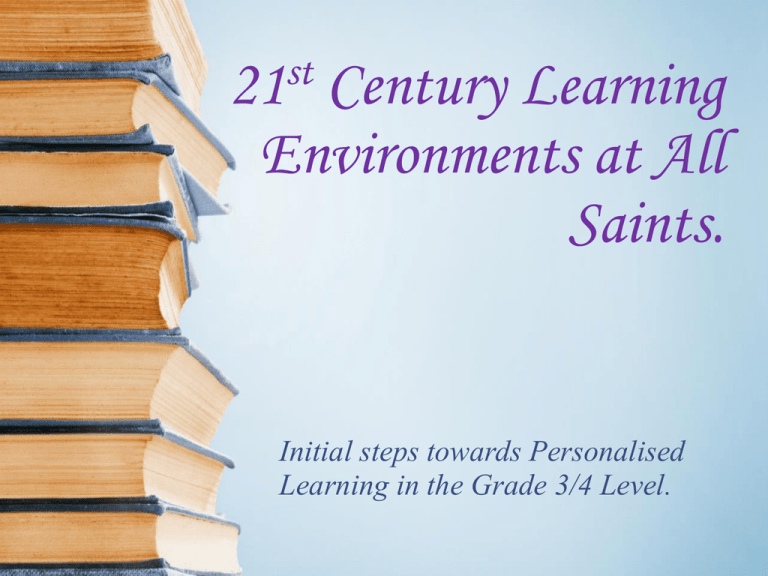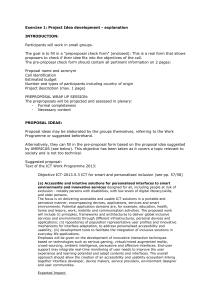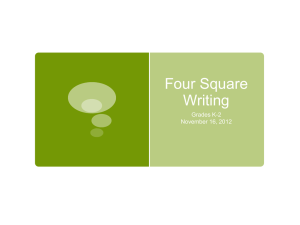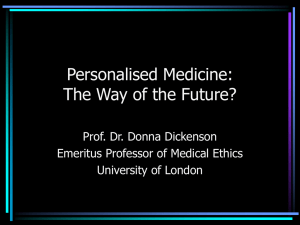File - All Saints Parish School
advertisement

st 21 Century Learning Environments at All Saints. Initial steps towards Personalised Learning in the Grade 3/4 Level. Things you should know: • What is best for your children is always at the centre of our thinking, actions and plans. • We are taking it slowly – small steps! • We are continually reflecting, assessing and modifying. • This is contemporary learning. Our definition of Personalised Learning at All Saints. Personalised learning means highly structured engagement which is collaborative, negotiated and takes into account individual student learning needs, prior knowledge and interests. Achievement is underpinned by rigorous planning and risk taking from both facilitators and students. It is focused on incorporating elements of student voice and providing opportunities for student choices about their learning. It requires the holistic, consistent, whole community involvement to support the success of each student. Teachers, students and parents will cooperate to provide ongoing detailed feedback, which will provide accurate information for planning and guiding student’s future learning. Why the change? • Providing opportunities to better cater for each student’s learning needs. • Students take more ownership and responsibility for their learning – Personal learning skills. • Students are more involved in their learning. – Interest based – Engaging to the students – Motivating – both through interests and seeing the possibility for improvement. Our Learning Centres Foundation – Discovery Centre Grade 1/2 – Inquiry Centre Grade 3/4 – Explore Centre Grade 5/6 – Quest Centre Specialist Areas – Global Centre (Information & Communication Technology, Performing Arts, Physical Education, Science and LOTE) Grade 3/4 Level Motto: ‘Explore, Discover, Achieve’ Symbol: A map. Specialist Areas • All students in the year level are split into three groups: Green group Purple group White group. • Each week each group attends a session of PE, Performing Arts and IT or Science. • Opportunity for students to develop many personal skills, e.g.; working with different people, coping with different social groups, self-organisation, etc. Goal Setting • Personal goals are being set by students for each curriculum area. The key focus is for students to: • Reflect upon their current understanding • With guidance, develop an understanding of knowledge and skills required to successfully fulfil an intended goal. • Monitor progress towards achieving a target goal. Learning Intentions To ensure students have a clear understanding of set tasks, we are beginning to implement Learning Intentions and Success Criteria. • A Learning Intention outlines what the overall knowledge, understanding and/or skills will be covered in a lesson. • The Success Criteria states what the student needs to be able to do to successfully complete set task. Example Learning intention We are learning to write a persuasive text with logically ordered paragraphs. Success criteria I can: – write a paragraph introducing the topic and expressing my opinion – write a paragraph stating a reason that supports my argument with examples – write a concluding paragraph re-stating my opinion with supporting reasons. Expectations on Students • Maintaining neat and organised bookwork. • Recording home reading and submitting homework/diaries on time. • Engaging in frequent conferencing with teachers to discuss successes/challenges. • Referring to maths groupings to find out where they need to be...a huge success! Future Direction • Personalised groupings in mathematics with extended implementation of workshops. • Inquiry curriculum will be explored as an entire learning centre, with teachers conducting workshops covering skills and knowledge required to complete set tasks. • Reading and writing to eventually be conducted in a similar format to our maths curriculum. How is Personalised Learning different? • Open, flexible learning spaces • Different teachers • More emphasis on collection and use of data in teaching. • Flexible groupings based on rigorous assessment. Students move when evidence is available to support acquisition of knowledge, understanding and skills. • Professional discussions to inform planning and groupings. The Traditional Classroom How we learnt at school was different. • Teacher directed • Open-ended tasks to try to cater for all abilities in the classroom • Assessment and data collection was the individual teacher’s responsibility • Planning and teaching of lessons was done by each teacher. MAI Data – Growth Point Allocation Personalised Maths Planner Personalised Learning Cohorts Daily 5 Inquiry We began this year with an inquiry unit called ‘Learning to Learn’. The focus of this unit was for students to identify and explore their preferred learning styles. Kinaesthetic – Body Smart Interpersonal – People Smart Logical – Number Smart Visual/Spatial – Picture Smart Linguistic – Word Smart Naturalistic – Nature Smart Musical – Music Smart Intrapersonal – Myself Smart Inquiry As students have become more aware of their own personal learning styles, we have been able to better cater for the diversity in our classrooms. We are now seeing students who are engaged and passionate about their learning in inquiry. The students have embraced this way of learning, and have shown determination and cooperation when completing their inquiry projects. Thanks for coming along, please join us for a cuppa!









